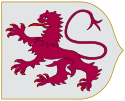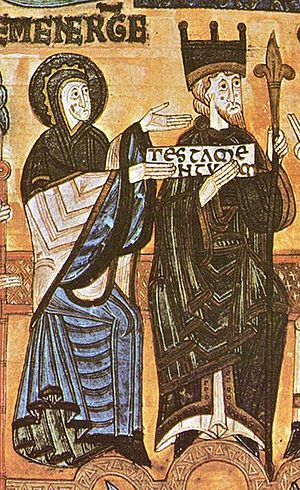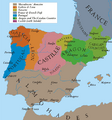Kingdom of León facts for kids
Quick facts for kids
Kingdom of León
|
|||||||||||||
|---|---|---|---|---|---|---|---|---|---|---|---|---|---|
| 910–1230 | |||||||||||||
|
|
|||||||||||||

The Kingdom of León (Green) in 1095.
|
|||||||||||||
| Capital | León | ||||||||||||
| Common languages | Astur-Leonese, Latin, Castilian, Mozarabic, Galician-Portuguese | ||||||||||||
| Religion | Roman Catholic | ||||||||||||
| Government | Feudal monarchy | ||||||||||||
| King | |||||||||||||
|
• 910–914
|
García I (first) | ||||||||||||
|
• 1188–1230
|
Alfonso IX (last) | ||||||||||||
| Legislature | Cortes of León | ||||||||||||
| Historical era | Middle Ages | ||||||||||||
|
• Established
|
10 December 910 | ||||||||||||
|
• Incorporated into the Crown of Castile
|
23 September 1230 | ||||||||||||
|
|||||||||||||
| Today part of | |||||||||||||
The Kingdom of León was an independent kingdom in the northwest of the Iberian Peninsula. It started in AD 910. Christian leaders from the Kingdom of Asturias moved their main city from Oviedo to León. This new kingdom was located along the northern coast of the peninsula, near the Bay of Biscay.
Around this time, the Caliphate of Córdoba was growing stronger. This powerful Muslim state began to attack León. The kings of León and Navarre teamed up against Córdoba. However, they lost a big battle at Valdejunquera in 920.
For the next 80 years, the Kingdom of León faced many challenges. There were civil wars and attacks from the Moors. Also, parts of the kingdom, like Galicia and Castile, started to become more independent. These problems made it harder for the Christian forces to take back land in Spain, a process known as the Reconquista.
Over time, parts of the Kingdom of León separated. The County of Castile became its own kingdom in 931. The County of Portugal became the independent Kingdom of Portugal in 1139. In 1230, the eastern part of León joined with the Kingdom of Castile.
From 1296 to 1301, the Kingdom of León was independent again for a short time. After that, it rejoined Castile. It remained a separate area within the Crown of Castile until 1833. From 1479, it was part of a united Spain.
In 1833, a royal rule divided the Kingdom of León into provinces. These were León, Zamora, and Salamanca. Later, in 1978, these three provinces joined with six provinces from Old Castile. Together, they formed the autonomous community called Castile and León. This is how the region is organized in modern Spain.
Contents
History of León
Early Beginnings
The city of León was first built by the Romans. It was a base for their Seventh Legion. The city was also an important place for trading gold. Gold was mined nearby at a place called Las Médulas.
In 540, the city was taken over by the Visigoths. Their king, Liuvigild, was an Arian Christian. He did not bother the Roman Catholic people who already lived there. In AD 717, León fell again, this time to the Moors.
Reconquista and Christian Rule
León was one of the first cities that Christians took back during the Reconquista. This was the effort to reclaim the Iberian Peninsula from Muslim rule. In AD 742, León became part of the Kingdom of Asturias.
At that time, León was a small town. But it was one of the few old Roman cities that was still important in the Kingdom of Asturias. In the past, it had been a bishopric, which is an area led by a bishop. Bringing León into Asturias helped the Asturian kings. It made their rule seem more official, especially as they wanted to lead a united Christian church. Most of the Iberian Peninsula was under Muslim rule at this time.
León in Modern Times
In the 1800s, the Kingdom of León, along with Galicia and Asturias, declared war against France. They set up their own government called the Junta General del Reino de León. The modern region of León was created in 1833. It was divided into the provinces of León, Zamora, and Salamanca.
Today, the region of León includes these three provinces. It is now part of the autonomous community of Castile and León. This community is part of the modern Kingdom of Spain.
Images for kids
See also
 In Spanish: Reino de León para niños
In Spanish: Reino de León para niños







